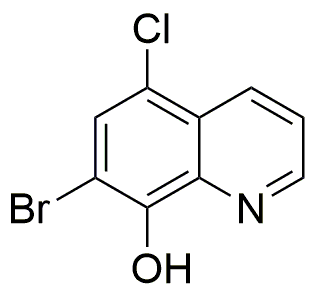7-Bromo-5-chloro-8-hydroxyquinoline is widely utilized in research focused on:
- Antimicrobial Applications: This compound is effective against various bacteria and fungi, making it valuable in developing new antimicrobial agents for pharmaceuticals.
- Analytical Chemistry: It serves as a reagent in analytical techniques, particularly in the detection of metal ions, enhancing the accuracy of environmental testing.
- Pharmaceutical Development: Its unique structure allows for modifications that can lead to new drug candidates, particularly in treating infections and diseases.
- Fluorescent Probes: The compound can be used in creating fluorescent probes for biological imaging, aiding researchers in visualizing cellular processes.
- Research on Metal Complexes: It forms stable complexes with metals, which are essential in studying coordination chemistry and developing catalysts.
Informations générales
Propriétés
Sécurité et réglementation
Applications
7-Bromo-5-chloro-8-hydroxyquinoline is widely utilized in research focused on:
- Antimicrobial Applications: This compound is effective against various bacteria and fungi, making it valuable in developing new antimicrobial agents for pharmaceuticals.
- Analytical Chemistry: It serves as a reagent in analytical techniques, particularly in the detection of metal ions, enhancing the accuracy of environmental testing.
- Pharmaceutical Development: Its unique structure allows for modifications that can lead to new drug candidates, particularly in treating infections and diseases.
- Fluorescent Probes: The compound can be used in creating fluorescent probes for biological imaging, aiding researchers in visualizing cellular processes.
- Research on Metal Complexes: It forms stable complexes with metals, which are essential in studying coordination chemistry and developing catalysts.
Documents
Fiches de données de sécurité (FDS)
La FDS fournit des informations de sécurité complètes sur la manipulation, le stockage et l’élimination du produit.
Spécifications du produit (PS)
Le PS fournit une description complète des propriétés du produit, notamment sa composition chimique, son état physique, sa pureté et les exigences de stockage. Il détaille également les plages de qualité acceptables et les applications prévues du produit.
Certificats d'analyse (COA)
Recherchez des certificats d'analyse (COA) en saisissant le numéro de lot du produit. Les numéros de lot et de lot se trouvent sur l'étiquette d'un produit, après les mots « Lot » ou « Lot de fabrication ».
Numéro de catalogue
Numéro de lot/série
Certificats d'origine (COO)
Ce certificat d'exploitation confirme le pays dans lequel le produit a été fabriqué, et détaille également les matériaux et composants utilisés et s'il est issu de sources naturelles, synthétiques ou autres sources spécifiques. Ce certificat peut être requis pour les douanes, le commerce et la conformité réglementaire.
Numéro de catalogue
Numéro de lot/série
Fiches de données de sécurité (FDS)
La FDS fournit des informations de sécurité complètes sur la manipulation, le stockage et l’élimination du produit.
DownloadSpécifications du produit (PS)
Le PS fournit une description complète des propriétés du produit, notamment sa composition chimique, son état physique, sa pureté et les exigences de stockage. Il détaille également les plages de qualité acceptables et les applications prévues du produit.
DownloadCertificats d'analyse (COA)
Recherchez des certificats d'analyse (COA) en saisissant le numéro de lot du produit. Les numéros de lot et de lot se trouvent sur l'étiquette d'un produit, après les mots « Lot » ou « Lot de fabrication ».
Numéro de catalogue
Numéro de lot/série
Certificats d'origine (COO)
Ce certificat d'exploitation confirme le pays dans lequel le produit a été fabriqué, et détaille également les matériaux et composants utilisés et s'il est issu de sources naturelles, synthétiques ou autres sources spécifiques. Ce certificat peut être requis pour les douanes, le commerce et la conformité réglementaire.


